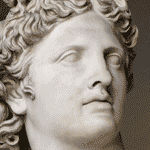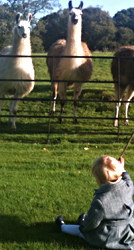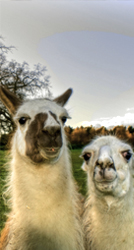17 Jul Introducing the A to Z of Dundas.. ‘A’ is for ‘Apollo’.
Starting today, we take you behind the scenes and under the skin of Dundas, with our new ‘A to Z’ series, highlighting the remarkable, the ancient, the unexpected and the overlooked aspects of this historic venue.
We begin the series with ‘A’ -for ‘Apollo’.
 Apollo was the mythical Greek god of music, poetry and the sun, amongst many other things. One of his more obscure areas of responsibility was over herds and flocks, which is perhaps why this name was chosen for our Apollo, the senior male in our twenty strong flock of Llamas! To find out more about these curious creatures, and how they came to make the elegant surroundings of Dundas Castle their home, read on..
Apollo was the mythical Greek god of music, poetry and the sun, amongst many other things. One of his more obscure areas of responsibility was over herds and flocks, which is perhaps why this name was chosen for our Apollo, the senior male in our twenty strong flock of Llamas! To find out more about these curious creatures, and how they came to make the elegant surroundings of Dundas Castle their home, read on..
Taking pride of place in a lush green field that lines the southerly approach to the castle and adjoins the front lawn, the Dundas Llamas are one of the more unusual features of the estate, never failing to illicit a response from new guests; sometimes surprise, sometimes amusement, always curiosity. The Llama’s have even found notoriety on this very blog, as part of an April 1 news story of dubious reliability! Native to South America, where they have been bred for centuries to carry heavy packs, they are naturally friendly and curious creatures, though guests wishing to take a closer look should be aware that spitting is natural Llama behaviour!
The original herd of 12 Llamas once lived in Cumbria, owned by a long standing family friend of Sir Jack’s. When the gentleman in question retired, in order to avoid splitting them up, Sir Jack agreed to take them on, providing a new home on the Dundas estate. Clearly they must enjoy their surroundings, as their number has now increased to over 20. Llamas have a complex and ever changing social pecking order, which they decide by skirmishes involving kicking, butting of chests, biting and the aforementioned spitting. With growth in numbers, young males have begun to challenge Apollo -now somewhat long in the tooth, for dominance, resulting in three distinct groupings within the one herd.
One of the questions we at the castle are often asked about the Llamas is ‘What are they for?’. Llamas have historically had many uses. Their excellent load bearing capacity makes them useful as beasts of burden. It is also possible to use their wool from their coats for the manufacture of various textiles, though they are less famous for this than their Alpaca cousins. They have also been bred for their meat. However, our Llamas are not expected to carry or toil, nor are they shorn of their coats, and (as we are sure you are relieved to hear) they are certainly not on the menu! They just ‘are’. A living monument to friendship and part of what makes Dundas so unique. We hope you enjoy making their acquaintance when your event is held at the castle.





